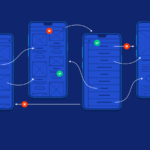Google Maps Directions Renderer is a powerful tool in JavaScript for displaying routes, step-by-step directions, and interactive maps. In this article, we’ll explore how developers can leverage their capabilities to enhance mapping functionalities in web applications.
What is Google Maps Directions Renderer?
Google Maps Directions Renderer is a component of the Google Maps JavaScript API that allows developers to render detailed directions between locations on a map. It enables the visualization of routes, waypoints, and turn-by-turn directions directly within web applications.

Displaying Routes on Maps
One of the primary uses of Google Directions Renderer is to display routes between two or more locations on a map. Developers can specify starting and ending points, along with optional waypoints, to generate and render the optimal route based on current traffic conditions.
Customizing Route Appearance
Developers can customize the appearance of routes rendered by Google Maps Directions Renderer. This includes defining colours, line styles, and markers to distinguish different segments of the route or highlight specific points of interest along the way.
Interactive Step-by-Step Directions
Google Maps Directions Renderer provides interactive step-by-step directions for navigating from the starting location to the destination. It breaks down the journey into individual instructions such as turning directions, street names, and distances, enhancing user guidance.
Dynamic Updating of Directions
In dynamic applications, developers can update directions in real-time using Google Directions Renderer. This is useful for scenarios where routes change due to user input, traffic updates, or alternative routes suggested by the Google Maps API.
Handling Multiple Travel Modes
The Directions Renderer supports various travel modes such as driving, walking, bicycling, and public transit. Developers can switch between these modes dynamically or allow users to choose their preferred mode of transportation for generating routes.
Integrating with Geolocation
By integrating Google Directions Renderer with geolocation services, developers can enhance the user experience by automatically detecting the user’s current location and providing directions from that point to the desired destination.
Utilizing Street View and Satellite Imagery
For richer visualization, Directions Renderer can integrate with Google Maps Street View and satellite imagery. This allows users to preview locations along the route through immersive 360-degree views or high-resolution aerial images.
Adding Waypoints and Stops
Developers can incorporate waypoints and stops into routes rendered by Google Directions Renderer. Waypoints enable users to specify intermediate locations to visit along the route, providing flexibility in trip planning and navigation.
Implementing Drag-and-Drop Functionality
Enhance user interaction by implementing drag-and-drop functionality with Google Directions Renderer. Users can adjust routes by dragging waypoints or modifying paths directly on the map, updating directions and route calculations in real time.
Embedding Directions in Websites
Google Directions Renderer facilitates the embedding of interactive maps and directions directly into websites and web applications. This enables businesses, travel websites, and navigation services to provide seamless mapping functionalities to their users.
Offline Support with Cached Routes
Applications utilizing Google Directions Renderer can support offline usage by caching routes and directions. Once loaded, cached directions remain accessible even without an internet connection, ensuring continuous usability in remote or low-connectivity areas.
Accessibility and Localization Features
Ensure accessibility and localization in global applications by utilizing Google Directions Renderer. It supports multiple languages for direction instructions and can accommodate accessibility features such as screen readers for visually impaired users.
Monitoring and Analytics
Developers can implement monitoring and analytics to track the usage of Google Directions Renderer within their applications. This helps in optimizing performance, identifying usage patterns, and ensuring compliance with API usage limits.
Security and Privacy Considerations
When integrating Google Directions Renderer, prioritize security and user privacy. Ensure secure transmission of location data and adhere to Google’s terms of service and privacy policies regarding the use of mapping and location-based services.
Future Enhancements and Updates
Stay updated with new features and enhancements introduced by Google Maps Directions Renderer. Regularly check for API updates, new functionalities, and improvements in performance and usability to benefit from the latest innovations.
Conclusion
Google Maps Directions Renderer empowers developers to integrate advanced mapping and navigation capabilities into web applications using JavaScript. By leveraging its features for displaying routes, step-by-step directions, and interactive maps, developers can create compelling user experiences that enhance navigation and location-based services.











